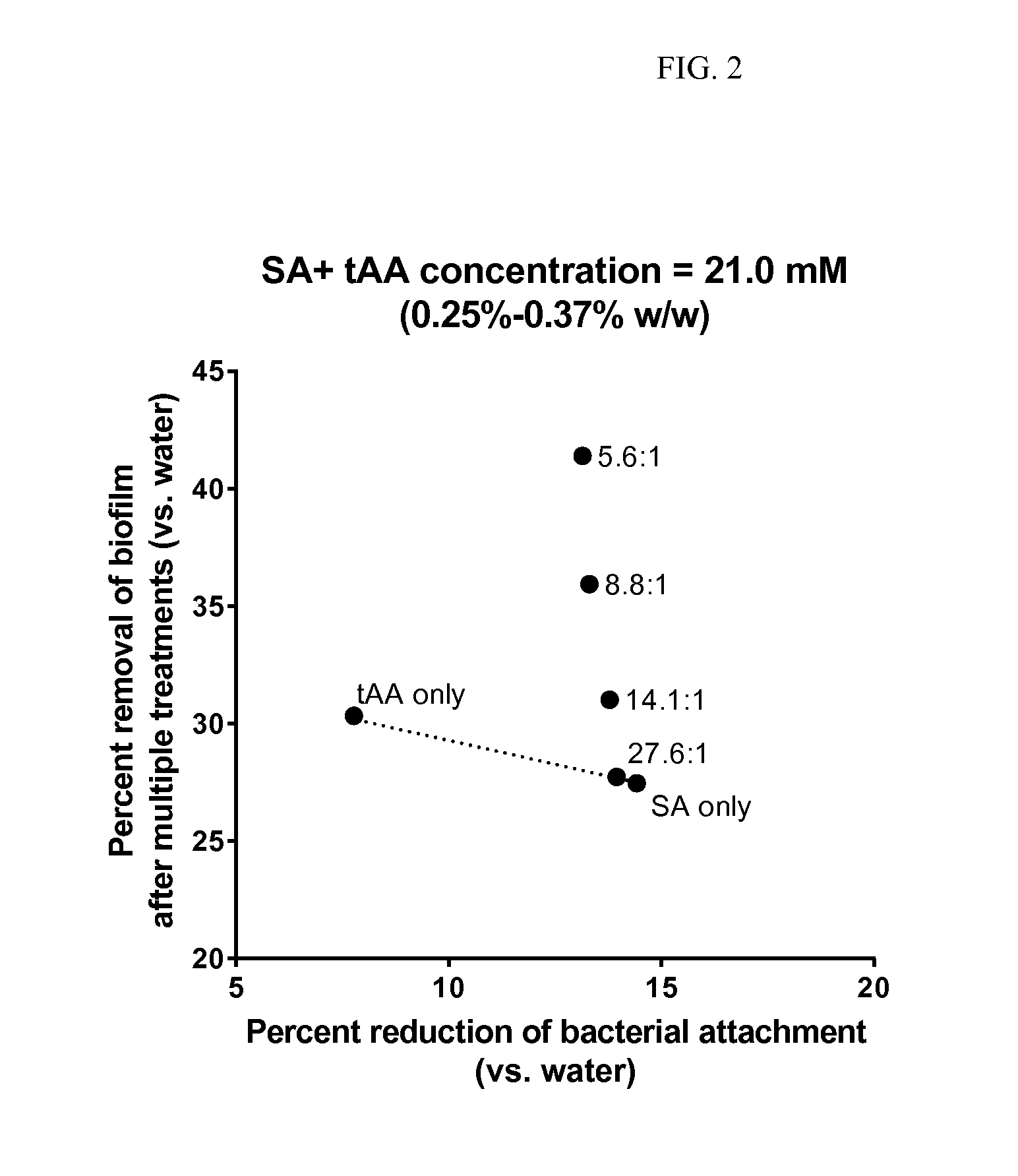Compositions comprising combinations of organic acids
a technology of organic acids and combinations, applied in the direction of antibacterial agents, drug compositions, biocides, etc., can solve the problems and achieve the effect of increasing biofilm disruption
- Summary
- Abstract
- Description
- Claims
- Application Information
AI Technical Summary
Benefits of technology
Problems solved by technology
Method used
Image
Examples
example 1
Biofilm Prevention Performance of Compounds
[0085]Formulations A1-J1 as shown in Table 1 were made by dissolving one of nine compounds: transcis-aconitic acid, succinic acid, adenosine, quinic acid, inosine, shikimic acid, uridine, oxalic acid, or epicatechin, in an aqueous solution containing ethanol and a benzoic acid buffer. Each of the nine formulations were tested in a biofilm prevention assay as described below.
[0086]The formulations were used to treat pellicle-coated hydroxyapatite peg lids by immersing the lids in the formulations as treatment solutions. The peg lids were then removed from the treatment solutions and inoculated overnight with human whole saliva, in order to generate a mixed species saliva-derived biofilm. The amount of biofilm grown on each peg lid was quantified by measuring ATP using a bioluminescence reaction, and compared to the amount of biofilm grown on a peg lid exposed to the benzoic acid / ethanol solution negative control (sample J). The results are r...
example 2
Exploration of Different Ratios and Concentration Ranges for Succinic Acid / Trans-Aconitic Acid
[0088]Succinic acid and trans-aconitic acid were formulated into full mouth rinse formulations and their concentrations and ratios were systematically varied. The amounts and materials of each formulation is shown on Tables 2 through 5. Formulations containing succinic acid, trans-aconitic acid, and blends of both succinic acid and trans-aconitic acid were made. The total concentration of succinic acid plus trans-aconitic acid used in the formulations shown on Tables 3 through 6 are 10.5 mM, 21 mM, 42 mM, and 63 mM, i.e. between 0.12% w / w and 1.1% w / w, respectively. These formulations were prepared by dissolving water soluble components, including succinic acid, trans-aconitic acid, Poloxamer 407, sodium lauryl sulfate, sodium benzoate, saccharin, sucralose, sorbitol, and FD&C Green#3, in water. Separately, all non-water soluble components, including menthol, thymol, eucalyptol, methyl sali...
example 3
Biofilm Prevention Performance of Compounds
[0102]Formulations A2-J2 as shown in Table 7 were made and tested in the biofilm prevention assay. The formulations were tested in an in-vitro static multi-treatment mixed species biofilm assay. Pellicle-coated peg lids were pre-treated with each formulation before biofilm growth. The treated peg lids were then inoculated with human whole saliva for 24 hours in order to grow a mixed species saliva-derived biofilm. This biofilm was treated with each formulation twice a day over the course of 60 hours, for a total of five 30-second treatments. The results are reported as log RLU and are shown in Table 7, with a lower value corresponding to less biofilm. The results were then used to create contour surfaces to maximize activity with varying concentrations of succinic acid and trans-aconitic acid. A positive control (Sample J2) comprised of a standard essential oil containing mouth rinse was also formulated and tested.
[0103]
TABLE 7Formulations ...
PUM
| Property | Measurement | Unit |
|---|---|---|
| Fraction | aaaaa | aaaaa |
| Fraction | aaaaa | aaaaa |
| Fraction | aaaaa | aaaaa |
Abstract
Description
Claims
Application Information
 Login to View More
Login to View More - R&D
- Intellectual Property
- Life Sciences
- Materials
- Tech Scout
- Unparalleled Data Quality
- Higher Quality Content
- 60% Fewer Hallucinations
Browse by: Latest US Patents, China's latest patents, Technical Efficacy Thesaurus, Application Domain, Technology Topic, Popular Technical Reports.
© 2025 PatSnap. All rights reserved.Legal|Privacy policy|Modern Slavery Act Transparency Statement|Sitemap|About US| Contact US: help@patsnap.com


